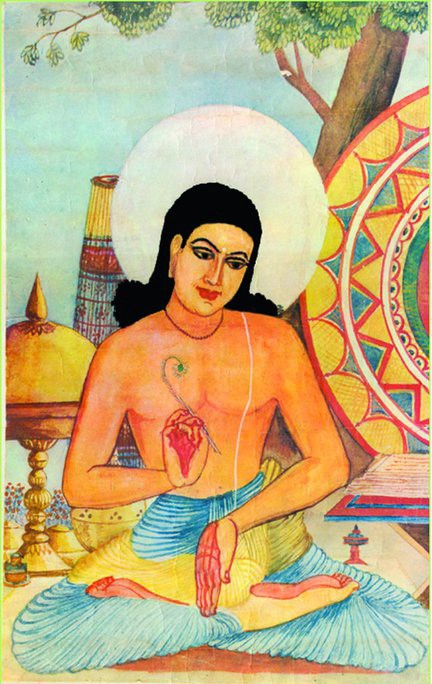
Disclaimer: Copyright infringement not intended.
Context
On a day Prime Minister Narendra Modi performed puja at the Ram temple at Ayodhya, Congress leader Rahul Gandhi was prevented from entering the premises of Batadrava Than, a Vaishnavite monastery and Sankardev’s birthplace in central Assam's Nagaon district.
Details
- Srimanta Sankardev was a 15th-century saint, scholar, cultural icon, and social reformer from the Indian state of Assam.
Early Life
- Srimanta Sankardev was born in 1449 in Bordowa, present-day Nagaon district, Assam, India.
- His birth name was Sankaravara, and he later became known as Sankardev.
- Sankardev experienced a spiritual awakening early in his life and devoted himself to the worship of God.
- He was deeply influenced by the Bhakti movement and the teachings of saints like Kabir and Sankaracharya.
Founding of Neo-Vaishnavism
- Srimanta Sankardev founded Neo-Vaishnavism, a form of the Bhakti movement that emphasized devotion to a personal god, particularly Lord Krishna.
Literary Contributions
- Introduced new forms of music (Borgeet), theatrical performance (Ankia Naat, Bhaona), dance (Sattriya), and literary language (Brajavali).
- Kirtans: Sankardev composed numerous Kirtans (devotional songs) that are sung during religious gatherings and festivals.
- Bhakti Literature: He wrote a collection of Borgeets (devotional songs), Bhaonas (religious dramas), and books promoting devotion and morality.
- Sankarvijaya: An important biography of Srimanta Sankardev written by his disciple Madhavdev.
Cultural Contributions
- Sattras: Sankardev established monastic institutions known as Sattras, which became centers for cultural and religious activities.
- Bhaona: He introduced Bhaona, a traditional form of one-act play with religious and moral themes, as a means of conveying spiritual messages.
- He created a distinct form of prayer hall called Namghar.
Social Reforms
- Anti-Caste Movement: Srimanta Sankardev opposed the caste system and promoted a society based on equality and fraternity.
- Women's Rights: He advocated for the upliftment of women and their active participation in religious and cultural activities.
- His followers, known as Bhakats, celebrate his teachings through festivals like Magh Bihu and commemorate his life through cultural events.
- Influenced the Koch and Ahom kingdoms, and his followers evolved into monastic centers called Sattras.
- Inspired the Bhakti movement in Assam, similar to the influence of other prominent figures like Guru Nanak, Ramananda, Namdev, Kabir, Basava, and Chaitanya Mahaprabhu in different parts of the Indian subcontinent.

Ekasarana Dharma
Neo-Vaishnavite Monolithic Sect:
- Ekasarana Dharma, meaning "Shelter-in-One religion," is a neo-Vaishnavite monolithic sect introduced by Srimanta Sankardev in Assam during the 15th-16th century.
Focus on Devotion to Krishna:
- The sect reduced emphasis on Vedic ritualism and instead emphasized devotion (bhakti) to Lord Krishna.
- Practices include congregational listening (shravan) and singing Krishna's name and deeds (kirtan).
Egalitarian Appeal:
- Attracted both Hindu and non-Hindu populations due to its simple and accessible nature.
- Initiation into the faith through a ceremony called "xoron-lowa," typically conducted by Sattradhikars (heads of monastic institutions called Sattras).
Central Religious Text - Bhagavat of Sankardeva:
- The Bhagavat of Sankardeva, a transcreation of the Sanskrit Bhagavata Purana, serves as the central religious text.
- Other important works include Kirtan Ghoxa by Sankardeva and Naam Ghoxa by Madhabdev.
Mahapuruxiya and Non-adherence to Hindu Varna System:
- Also known as Mahapuruxiya, based on the worship of the Mahapurux or Mahapurush.
- The sect historically rejected the Hindu varna system and opposed caste distinctions.
Nature of God and Salvation:
- Ekasarana acknowledges both the impersonal (nirguna) and personal (saguna) aspects of God.
- Narayana is considered the worshipful god, and Krishna is identified as the supreme entity.
Four Principles:
- Naam (chanting and singing the name and qualities of God).
- Deva (worship of a single God, Krishna).
- Guru (reverence for a Guru or Spiritual Preceptor).
- Bhakat (association or congregation of devotees).
Denominations:
- The sect fissured into four sanghatis (sub-sects) after the death of Srimanta Sankardev, each emphasizing different aspects of the four principles.
Different Sanghatis:
- Brahma sanghati, Purush sanghati, Nika sanghati, and Kala sanghati, each with distinct characteristics and emphasis on certain principles.
- Brahma Sanghati: Developed by followers who moved away from Madhabdev's leadership, allowing some elements of Brahminical orthodoxy.
- Purush Sanghati: Initiated by the grandsons of Sankardeva, emphasizing Naam and tolerating some Brahminical rites.
- Nika Sanghati: Emphasizes sat-sanga and strict codes for purity and cleanliness, strictly prohibiting idol worship.
- Kala Sanghati: Emphasizes Guru, successfully initiated many tribal and socially backward groups, and had a significant following.

Conclusion
Srimanta Sankardev's life and work exemplify a harmonious integration of spirituality, culture, and social reform, making him a revered figure in the history of Assam and a key influencer in the broader context of the Bhakti movement in the Indian subcontinent.
|
PRACTICE QUESTION
Q. Srimanta Sankardev's multifaceted contributions in the realms of religion, culture, and social reform continue to shape the ethos of Assam, making him a revered figure in the history of India's cultural and spiritual heritage. Discuss. (250 Words)
|




